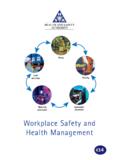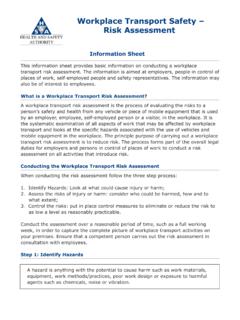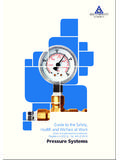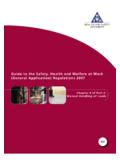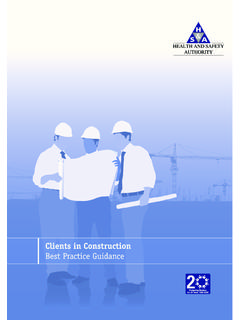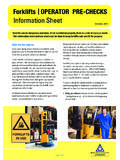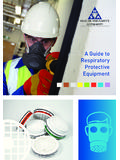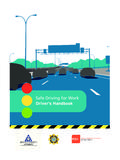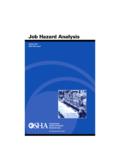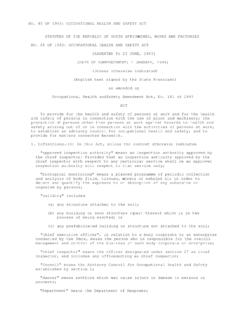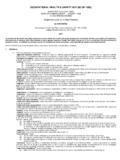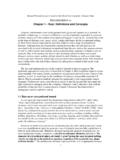Transcription of Guide on Manual Handling Risk Assessment in the ...
1 Guide on Manual Handling Risk Assessment in the Manufacturing Sector Our vision: A country where worker safety, health and welfare and the safe management of chemicals are central to successful enterprise Contents INTRODUCTION ..2. THE BUSINESS CASE FOR MANAGING Manual Handling IN THE MANUFACTURING SECTOR ..3. WHY IS THERE A NEED TO MANAGE THE HAZARD OF Manual Handling IN THE WORKPLACE? ..5. THE Manual Handling RISK Assessment PROCESS ..8. Manual Handling RISK Assessment CASE STUDIES ..10. APPENDIX 1: Manual Handling RISK Assessment WORKSHEET.
2 15. APPENDIX 2: EXAMPLES OF RISK FACTORS FOR Manual Handling OF LOADS ..17. APPENDIX 3: EXAMPLE OF A SAFE SYSTEM OF WORK PLAN (SSWP) ..18. Published in 2013 by the Health and Safety Authority, The Metropolitan Building, James Joyce Street, Dublin 1. Guide on Manual Handling Risk Assessment in the Manufacturing Sector INTRODUCTION. This Guide gives direction and practical information to those that work in the manufacturing sector on action that can be taken to manage the potential hazard of Manual Handling in the workplace.
3 This is necessary in order to work towards preventing musculoskeletal injuries at work and reducing exposure to high financial costs including compensation claims. The objectives of providing such information are: To raise awareness of the business case for managing the hazard of Manual Handling To explain why the hazard of Manual Handling needs to be managed in the workplace To help employers understand and recognise what the potential risk factors are in relation to Manual Handling in their workplace To give direction on Manual Handling risk Assessment and how it can be used to highlight potential hazards and create opportunities for developing better ways of working including use of Handling aids.
4 Improved housekeeping or better organisation of work processes resulting in reduced Handling of stock and reduced risk of musculoskeletal injury To explain how to complete a Manual Handling risk Assessment process through illustrated case studies To give direction on developing a safe system of work plan The manufacturing sector covers a wide range of different business types including metalwork, woodworking, food processing, electronics, plastics and medical device production. The tasks conducted in the manufacturing sector require people to engage in different types of activity which sometimes may require Manual Handling .
5 Not all Manual Handling is hazardous; however, in some cases the activity will require a person to engage in a work practice which may involve a significant amount of Handling , including lifting heavy loads or lifting loads above shoulder height. It is important to be aware that Manual Handling can be a potential workplace hazard which can result in a person suffering a musculoskeletal injury such as a back injury and therefore needs to be managed effectively. Page 2. Guide on Manual Handling Risk Assessment in the Manufacturing Sector THE BUSINESS CASE FOR MANAGING Manual Handling IN THE MANUFACTURING SECTOR.
6 Injuries due to Manual Handling account for 33% of all accidents reported to the Health and Safety Authority each year, and nearly 20% of these Manual Handling accidents take place in the manufacturing sector. A review of figures in the Health and Safety Authority 2011 Annual Statistics show that 49% of the Manual Handling injuries in the manufacturing sector occurred when the person was lifting or carrying a load. Figures from the Personal Injuries Assessment Board (PIAB) show that in 2008 million was awarded in respect of 972 employer liability awards.
7 Just over one in five ( ) of these awards were to people working in the manufacturing sector. Further analysis of the data shows that sprains ( ) are the most common injury resulting in a claim. The average employer liability award for 2008 was 32,266. Musculoskeletal injuries at work are a massive drain on the resources of an employer, including costs such as sick pay, lost productivity, retraining, legal fees and injury benefit. They represent a significant opportunity for cost reduction, since they are manageable and preventable.
8 A study of civil court judgements on cases concerning injury due to Manual Handling identified the following key systems failures when making rulings on compensation claims: (Health and Safety Review, 2000). No risk Assessment of work activities Lack of safe system of work plans Mechanical aids were not provided and maintained Adequate training was not provided No evidence of work supervision The case study below demonstrates how tangible improvements are possible if action is taken to address systems failures such as those outlined above.
9 The interventions were introduced at a medium-sized Irish manufacturing company. Page 3. Guide on Manual Handling Risk Assessment in the Manufacturing Sector Problem identification The production process required a significant level of Manual Handling . A number of risk factors resulted including: - Repetitive bending during a packing operation - Large, awkward and heavy parts carried over long distances As a result there were a high level of reportable injuries due to unsafe Manual Handling practice, and insurance costs running at 60,000 per year.
10 Management interventions Management agreed to implement a risk reduction strategy which included: - Managers being trained to conduct risk assessments - The completion of a Manual Handling risk Assessment of operations - Changes being made to work practices to reduce the Manual Handling risk factors. These improvements included the introduction of variable height pallet trucks and hydraulic trollies, the transporting of large parts on wheels, training of staff and new housekeeping procedures Results - No reportable injuries - Insurance costs reduced to 18,000 per year Page 4.
